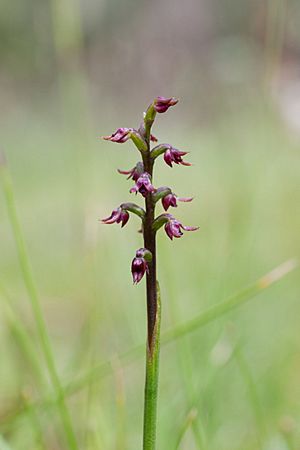Corunastylis facts for kids
Quick facts for kids Midge orchids |
|
|---|---|
 |
|
| Corunastylis nuda, a tiny midge orchid | |
| Scientific classification |
|
| Kingdom: | Plantae |
| Clade: | Tracheophytes |
| Clade: | Angiosperms |
| Clade: | Monocots |
| Order: | Asparagales |
| Family: | Orchidaceae |
| Subfamily: | Orchidoideae |
| Tribe: | Diurideae |
| Subtribe: | Prasophyllinae |
| Genus: | Corunastylis Fitzg. |
| Type species | |
| Corunastylis apostasioides |
|
| Synonyms | |
|
|
Corunastylis is a group of about 50 different plant species in the orchid family. People often call them midge orchids or pygmy orchids because they are usually very small. These plants grow in the ground and are perennial, meaning they live for more than two years. They are also deciduous, so their leaves fall off at certain times. You can find them in Australia, New Zealand, and New Caledonia. Midge orchids are quite similar to other orchids in the genus Genoplesium, and sometimes they have even been grouped together.
Contents
What Do Midge Orchids Look Like?
All midge orchids grow in the ground. They are perennial plants that lose their leaves, and they grow from underground tubers, which are like small storage organs. Each plant has a single, thin, hollow, tube-shaped leaf. This leaf wraps around the flowering stem, with only a short tip sticking out freely.
Tiny Flowers on a Thin Stem
Midge orchids have many tiny flowers, sometimes up to fifty, packed closely together on a thin flowering stem. Just like leek orchids, their flowers are upside down! This means the labellum (which is like the orchid's "lip") is above the column (the central part of the flower) instead of below it.
The sepals and petals (parts of the flower that look like petals) can be hairy in some midge orchid species, but smooth in others. They often have a small gland (a tiny bump that might produce a scent or liquid) near their tips. The labellum is attached by a small hinge. In some species, it can even wiggle and vibrate with the slightest breeze!
How Midge Orchids Got Their Name
The scientific name Corunastylis comes from two ancient Greek words. "Coruna" means "a thick stick," and "stylis" means "a style." This name likely describes a part of the orchid's flower.
A Changing Identity
The history of naming midge orchids is a bit complicated! In 1888, a scientist named Robert Fitzgerald first officially described Corunastylis apostasioides. He published this description in a book called Australian Orchids.
Later, in 1889, another scientist named Mueller changed the name to Prasophyllum apostasioides. Then, in 1989, David Jones and Mark Clements moved this orchid and most other Prasophyllum species into the genus Genoplesium. But wait, there's more! In 2002, Jones and Clements decided to move almost all Genoplesium species back into Corunastylis. Only one species, Genoplesium baueri from New South Wales, stayed in Genoplesium.
Not all plant experts agree with these changes. For example, the World Checklist of Selected Plant Families (a big list of plant names kept by Royal Botanic Gardens, Kew) still uses the name Genoplesium for many of these orchids. However, Australian experts often use Corunastylis.
Where Midge Orchids Live
Most midge orchids are found only in eastern Australia. This means they are endemic to that area. However, two species, C. nuda and C. pumila, also grow in New Zealand. One species, Corunastylis caloptera, is found only in New Caledonia.
Finding Their Home
These tiny orchids often grow in damp places. You might find them among rushes or sedges, which are grass-like plants. Because they are so small and blend in with these other plants, midge orchids can be quite hard to spot!
How Midge Orchids Reproduce
Most Corunastylis species rely on small vinegar flies to help them reproduce. The orchids produce a special scent from tiny glands on their flowers. This scent attracts the vinegar flies, which then help carry pollen from one flower to another. This process is called pollination.
However, some midge orchid species don't need flies to pollinate them. They are self-pollinating, meaning they can pollinate themselves.
Images for kids
-
Corunastylis nuda, the tiny midge orchid


